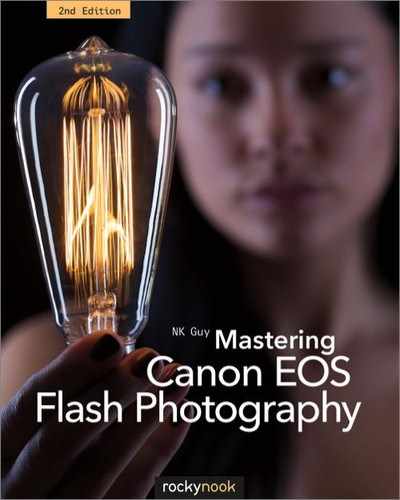Appendix B: Choosing a Flash Unit
Choosing the right flash unit for a job depends on a host of factors. There is no one perfect flash unit for all purposes.
Before shopping for a flash unit, consider how it’s likely to be used. Is it needed just for occasional snapshots? For heavy use out in the field? For indoor amateur studio work? What about size and weight? After all, a high-end flash unit is bigger than a consumer camera. What budget restrictions are there? Are there any plans to expand to a wireless system, or is a single on-camera flash unit adequate?
Here are a few suggestions for various types of flash usage.
A flash unit for casual and occasional use with a Canon digital camera
Recommended:
- If you plan on using radio wireless (and you should), the 430EX III-RT is a surprisingly capable and full-featured product. If you’re on a budget, the earlier 430EX and 430EX II models are fine if you just want a lightweight on-camera unit, but don’t foresee moving into radio wireless.
- The pocketable 270EX II is useless as an on-camera unit, but is a fun low-power optical slave, especially if your camera can use its built-in flash unit as a Speedlite master.
Not recommended:
- E and EZ models don’t meter with digital cameras. Avoid these!
- The 380EX lacks swivel and wireless slave capabilities. The 420EX lacks manual controls and has no FEC on some consumer bodies.
- The 500/600 EX units are quite large and expensive, and may be overkill for casual use.
- Rock-bottom cheap flash units billed as “Canon compatible” should always be considered with caution. Never buy one without testing it first, as many have compatibility issues.
- Don’t buy the 430EX III or 600EX. Go for the RT radio-equipped versions.
Advanced use with a Canon digital camera
Recommended:
- The 600EX-RT is expensive, but can do everything you’d want a flash unit to do, including working with Canon’s radio wireless system. If you really want to stick with optical wireless, the 580EX is the most convenient to use.
Not recommended:
- Avoid any flash units that lack wireless controls and manual output, as they place limits on future expansion.
A flash system for wireless E-TTL
One’s first inclination might be to buy a 500 series unit as a master and a 400 series as a remote slave. The trouble is, in terms of power output, it makes more sense to have the master provide on-camera fill and the slave provide the main light. I also recommend using radio wireless E-TTL, if your budget can handle it, since optical wireless E-TTL is far less reliable.
Recommended:
- Two 430EX III-RT units, each of which can serve as either master or slave in radio mode. Or a 430EX III-RT master with a 600EX-RT slave. The Yongnuo clone of the 600EX-RT is also surprisingly good if you’re on a budget, though it quickly drains batteries.
Not recommended:
- The ST-E2 is fairly useless. Older 5xx series EX units are okay for optical wireless only.
A flash unit for all-manual work, Strobist-style
Here, it all depends on your priorities. Is you goal to use manual flash exclusively, or do you want to build a system that can be used both automatically and manually? Relatively few of Canon’s flash units are suited solely for manual work, because they’re optimized for automatic use.
Recommended:
- Any battery-powered flash unit from any manufacturer works well, as long as it has manual output controls. However, a built-in sync port, the ability to recycle the unit quickly, and a zooming flash head are very useful features. Canon 500/600 EX units are fine for this, but they are expensive choices, unless they’re also being used for their automatic capabilities.
- A fully automatic flash unit that lacks manual controls is useless.
- A flash unit with auto power-off that can’t be overridden, especially if the power-off timer is less than 5 minutes.
- An older unit with high voltages on its flash foot can sometimes damage cameras or wireless triggers.
- Any third-party flash unit that can’t fire when the center pin is triggered.
A flash unit for macro photography
While specialized macro units are very handy tools, it’s possible to use regular flash units as well. Any flash unit positioned off-camera with a suitable diffuser can serve as a good macro flash unit; it’s simply more awkward to use.
Recommended:
- The MR-14EX is good if a ring-type flash unit is needed, though its flat light isn’t suitable for all subjects. The MT-24EX is expensive, and its ability to move flash heads independently is valuable for some types of photography but not others.
Not recommended:
- The ML-3 is TTL only and lacks manual controls; useless for digital cameras. The Sigma EM-140 DG is not a true ring flash, and doesn’t offer significant enough savings to make it a better choice than the MR-14EX. The MR-14EX II has a nice screen, but is rather expensive for what you get.
